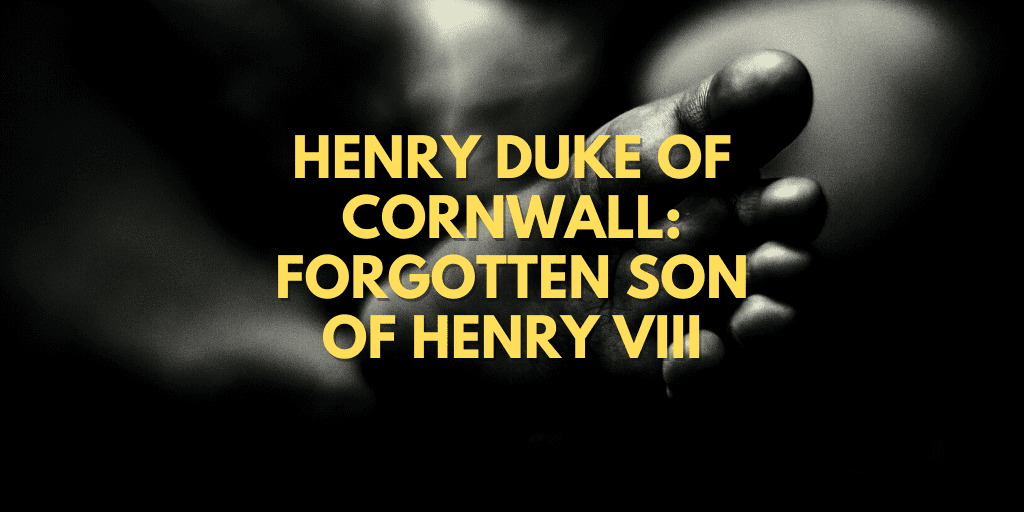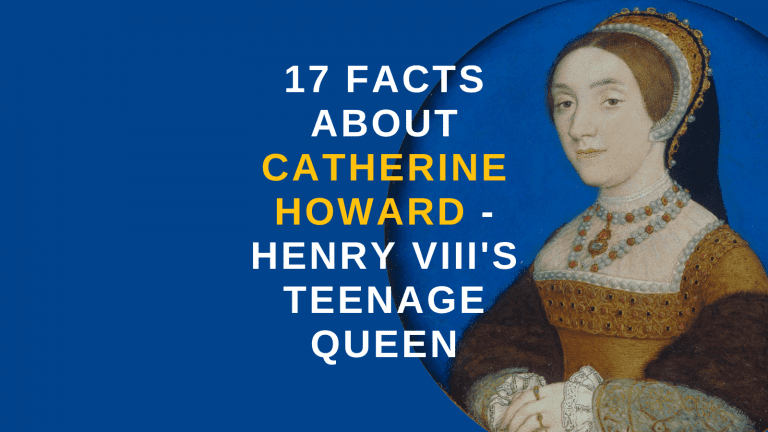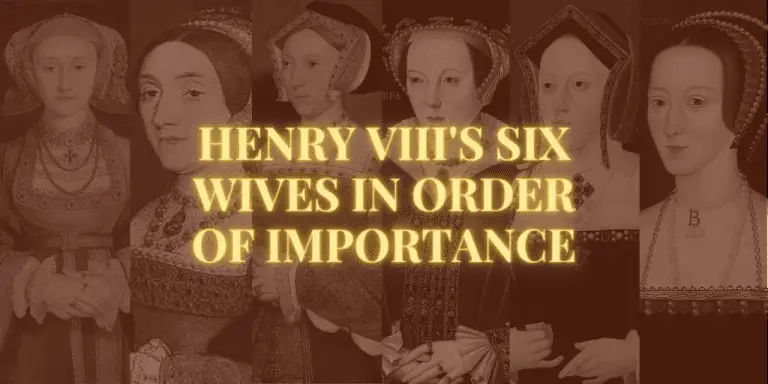Henry Duke of Cornwall: Forgotten Son of Henry VIII
[et_pb_section fb_built=”1″ _builder_version=”4.15″ _module_preset=”default” global_colors_info=”{}”][et_pb_row _builder_version=”4.15″ _module_preset=”default” global_colors_info=”{}”][et_pb_column type=”4_4″ _builder_version=”4.15″ _module_preset=”default” global_colors_info=”{}”][et_pb_text _builder_version=”4.15″ _module_preset=”default” global_colors_info=”{}”]
Henry Duke of Cornwall is King Henry VIII’s forgotten son.
Every schoolchild in England will tell you that the legendary monarch, King Henry VIII, only ever had one son. The future Edward VI was the only child of Henry’s third wife, Jane Seymour.
Some schoolchildren in the country might tell you that Henry VIII had an illegitimate son, Henry Fitzroy, Duke of Richmond and Somerset. Fitzroy was the son of his longtime mistress, Bessie Blount.
Other students might be able to suggest that maybe the King had more illegitimate sons knocking around. However, if that is true, none other than Henry Fitzroy were acknowledged by him.
However, very few schoolchildren will mention Henry Duke of Cornwall. It’s almost as if the child has been removed from history.
Many people will be shocked to realise that Henry Duke of Cornwall was the son of Henry VIII and Catherine of Aragon.
“Wait,” I hear you cry. “Catherine of Aragon only gave birth to a daughter, Mary Tudor.”
Mary Tudor became Queen Mary on the death of her half-brother Edward VI and was infamously nicknamed Bloody Mary.
Well, no, unfortunately, that learning is incorrect.
And it seems strange that Prince Henry is forgotten because often there are debates that Henry the Eighth had an inability to father male children. It suggested that this is a reason for his obsessive nature regarding siring an heir.
But as we will see, Henry VIII had no problem in fathering male children.
Strangely enough, the tournament that was held to celebrate the birth of the young Prince is probably better remembered than the child himself.
Hopefully, this article will help set the record straight.
[/et_pb_text][/et_pb_column][/et_pb_row][et_pb_row _builder_version=”4.15″ _module_preset=”default” global_colors_info=”{}”][et_pb_column type=”4_4″ _builder_version=”4.15″ _module_preset=”default” global_colors_info=”{}”][et_pb_image src=”http://historywithhenry.com/wp-content/uploads/2021/08/HenryVIII_1509.jpg” _builder_version=”4.15″ _module_preset=”default” global_colors_info=”{}”][/et_pb_image][/et_pb_column][/et_pb_row][et_pb_row column_structure=”1_5,3_5,1_5″ _builder_version=”4.15″ _module_preset=”default” global_colors_info=”{}”][et_pb_column type=”1_5″ _builder_version=”4.15″ _module_preset=”default” global_colors_info=”{}”][/et_pb_column][et_pb_column type=”3_5″ _builder_version=”4.15″ _module_preset=”default” global_colors_info=”{}”][et_pb_text _builder_version=”4.15″ _module_preset=”default” global_colors_info=”{}”]
[/et_pb_text][/et_pb_column][et_pb_column type=”1_5″ _builder_version=”4.15″ _module_preset=”default” global_colors_info=”{}”][/et_pb_column][/et_pb_row][et_pb_row _builder_version=”4.15″ _module_preset=”default” global_colors_info=”{}”][et_pb_column type=”4_4″ _builder_version=”4.15″ _module_preset=”default” global_colors_info=”{}”][et_pb_text _builder_version=”4.15″ _module_preset=”default” global_colors_info=”{}”]
The Birth of Prince Henry, Duke of Cornwall
[/et_pb_text][/et_pb_column][/et_pb_row][et_pb_row _builder_version=”4.15″ _module_preset=”default” global_colors_info=”{}”][et_pb_column type=”4_4″ _builder_version=”4.15″ _module_preset=”default” global_colors_info=”{}”][et_pb_text _builder_version=”4.15″ _module_preset=”default” global_colors_info=”{}”]
[/et_pb_text][/et_pb_column][/et_pb_row][et_pb_row column_structure=”1_3,1_3,1_3″ _builder_version=”4.15″ _module_preset=”default” global_colors_info=”{}”][et_pb_column type=”1_3″ _builder_version=”4.15″ _module_preset=”default” global_colors_info=”{}”][/et_pb_column][et_pb_column type=”1_3″ _builder_version=”4.15″ _module_preset=”default” global_colors_info=”{}”][et_pb_image src=”http://historywithhenry.com/wp-content/uploads/2021/08/Michel_Sittow_002.jpg” _builder_version=”4.15″ _module_preset=”default” global_colors_info=”{}”][/et_pb_image][/et_pb_column][et_pb_column type=”1_3″ _builder_version=”4.15″ _module_preset=”default” global_colors_info=”{}”][/et_pb_column][/et_pb_row][et_pb_row column_structure=”1_5,3_5,1_5″ _builder_version=”4.15″ _module_preset=”default” global_colors_info=”{}”][et_pb_column type=”1_5″ _builder_version=”4.15″ _module_preset=”default” global_colors_info=”{}”][/et_pb_column][et_pb_column type=”3_5″ _builder_version=”4.15″ _module_preset=”default” global_colors_info=”{}”][et_pb_text _builder_version=”4.15″ _module_preset=”default” global_colors_info=”{}”]
[/et_pb_text][/et_pb_column][et_pb_column type=”1_5″ _builder_version=”4.15″ _module_preset=”default” global_colors_info=”{}”][/et_pb_column][/et_pb_row][et_pb_row _builder_version=”4.15″ _module_preset=”default” global_colors_info=”{}”][et_pb_column type=”4_4″ _builder_version=”4.15″ _module_preset=”default” global_colors_info=”{}”][et_pb_text _builder_version=”4.15″ _module_preset=”default” global_colors_info=”{}”]
It was a mere 18 months after the wedding of Henry VIII and Catherine of Aragon. Any suggestions of infertility in either of them (I have seen many) are completely unfounded.
Before her confinement, Henry arranged a series of lavish entertainments and mummings for his Queen. The ambassadors from Spain were also invited to attend. Henry was the centre stage in many of these entertainments taking leading roles. In one performance, Henry and fifteen masked gentlemen danced with ladies dressed in fine clothing embroidered with Catherine’s pomegranate symbol. As was customary, everyone gasped in astonishment when the ladies removed the masks of the gentlemen, and Henry was revealed. Not that many at court were the stature of the King, so how he thought a velvet mask might conceal him is anyone’s guess.
[/et_pb_text][/et_pb_column][/et_pb_row][et_pb_row _builder_version=”4.15″ _module_preset=”default” global_colors_info=”{}”][et_pb_column type=”4_4″ _builder_version=”4.15″ _module_preset=”default” global_colors_info=”{}”][et_pb_image src=”http://historywithhenry.com/wp-content/uploads/2021/08/Wyngaerde_Richmond_1562.jpg” _builder_version=”4.15″ _module_preset=”default” global_colors_info=”{}”][/et_pb_image][/et_pb_column][/et_pb_row][et_pb_row column_structure=”1_5,3_5,1_5″ _builder_version=”4.15″ _module_preset=”default” global_colors_info=”{}”][et_pb_column type=”1_5″ _builder_version=”4.15″ _module_preset=”default” global_colors_info=”{}”][/et_pb_column][et_pb_column type=”3_5″ _builder_version=”4.15″ _module_preset=”default” global_colors_info=”{}”][et_pb_text _builder_version=”4.15″ _module_preset=”default” global_colors_info=”{}”]
[/et_pb_text][/et_pb_column][et_pb_column type=”1_5″ _builder_version=”4.15″ _module_preset=”default” global_colors_info=”{}”][/et_pb_column][/et_pb_row][et_pb_row _builder_version=”4.15″ _module_preset=”default” global_colors_info=”{}”][et_pb_column type=”4_4″ _builder_version=”4.15″ _module_preset=”default” global_colors_info=”{}”][et_pb_text _builder_version=”4.15″ _module_preset=”default” global_colors_info=”{}”]
On the First of January 1511 at Richmond Palace. Queen Catherine of Aragon gave birth to a healthy baby boy.
He was named Henry after his father and grandfather, and everyone expected that in due course, he would become King Henry IX.
He was christened on the 5th of January in a lavish ceremony at the Church of the Observant Friars next to Richmond Palace. The young Prince’s godfathers were King Louis XII of France and the Archbishop of Canterbury, William Warham. His godmother was Margaret of Austria, the Duchess of Savoy. Of course, neither personally attended the christening. Louis XII of France presented some magnificent gifts; a fine gold salt and a cup weighing 99 ounces.
The young boy was baptised in a silver font brought from the cathedral by the Archbishop of Canterbury. It was the same font that his father himself had been baptised in.
There were many celebrations to mark the arrival of a new heir. Royal proclamations were given in the major cities. Massive bonfires were lit in the Prince’s honour throughout London. Orders were given to the Mayor that free wine must be given to the population. The cannon fired a salute at Tower Wharf.
It seemed that everyone benefited, especially the midwife responsible for the safe delivery of the child. She was presented with a large cash reward.
Henry VIII himself went on a pilgrimage to Our Lady of Walsingham in Norfolk. He left an offering of £1 13s 4d. It seemed a pitiful amount considering the gifts given to the midwife and what was to come.
[/et_pb_text][/et_pb_column][/et_pb_row][et_pb_row _builder_version=”4.15″ _module_preset=”default” global_colors_info=”{}”][et_pb_column type=”4_4″ _builder_version=”4.15″ _module_preset=”default” global_colors_info=”{}”][et_pb_text _builder_version=”4.15″ _module_preset=”default” global_colors_info=”{}”]
The Westminster Tournament
[/et_pb_text][/et_pb_column][/et_pb_row][et_pb_row _builder_version=”4.15″ _module_preset=”default” global_colors_info=”{}”][et_pb_column type=”4_4″ _builder_version=”4.15″ _module_preset=”default” global_colors_info=”{}”][et_pb_text _builder_version=”4.15″ _module_preset=”default” global_colors_info=”{}”]
Immediately plans were put into place to hold a grand tournament to celebrate the birth. It took until February 1511 for this spectacular event to occur, and by the time it had finished, it had cost over £4000. Catherine had been churched and was back at court and took a full part in the proceedings.
This became known as the Westminster Tournament, depictions of which are recorded via long illuminated vellum roll, which is now held at the College of Arms. It was in this tournament that Henry VIII himself fought under the moniker of Sir Loyal Heart.
The proceedings took place over several days. They were begun with a pageant on wheels drawn by a mechanical lion of gold and an antelope of silver. It unfolded in front of the Queen and her ladies to reveal a “forest” and a castle made of gold paper. In the castle was a maiden who presented the Queen with a garland of silk roses.
The King fought in the daily jousts and rode a dark grey horse. The horse had trappings of dark blue and the letter K for “Katherine.”
[/et_pb_text][/et_pb_column][/et_pb_row][et_pb_row _builder_version=”4.15″ _module_preset=”default” global_colors_info=”{}”][et_pb_column type=”4_4″ _builder_version=”4.15″ _module_preset=”default” global_colors_info=”{}”][et_pb_image src=”http://historywithhenry.com/wp-content/uploads/2021/08/2880px-10._Westminster_Roll_selected_scenes_260814_005_A5-scaled.jpg” _builder_version=”4.15″ _module_preset=”default” global_colors_info=”{}”][/et_pb_image][/et_pb_column][/et_pb_row][et_pb_row _builder_version=”4.15″ _module_preset=”default” global_colors_info=”{}”][et_pb_column type=”4_4″ _builder_version=”4.15″ _module_preset=”default” global_colors_info=”{}”][et_pb_text _builder_version=”4.15″ _module_preset=”default” global_colors_info=”{}”]
Note on the spelling of Katherine of Aragon or Catherine: The two spellings are used interchangeably. As the major sources on the internet tend to use the letter C, this was decided to be used on this blog.
Amongst the competitors in the jousts were the King’s friend and future brother-in-law Charles Brandon and his future father-in-law Thomas Boylen.
On the final day of jousting, Henry ran twenty-eight courses and broke twelve lances in the process.
That evening there was a banquet at the Palace of Westminster where the King gave away some of the golden “H” and “K” letters sew into his jacket.
The Westminster tournament is widely considered to be the most extravagant of Henry’s entire reign.
However, the celebrations were to be short-lived.
[/et_pb_text][/et_pb_column][/et_pb_row][et_pb_row _builder_version=”4.15″ _module_preset=”default” global_colors_info=”{}”][et_pb_column type=”4_4″ _builder_version=”4.15″ _module_preset=”default” global_colors_info=”{}”][et_pb_text _builder_version=”4.15″ _module_preset=”default” global_colors_info=”{}”]
The Death of Prince Henry, Duke of Cornwall
[/et_pb_text][/et_pb_column][/et_pb_row][et_pb_row _builder_version=”4.15″ _module_preset=”default” global_colors_info=”{}”][et_pb_column type=”4_4″ _builder_version=”4.15″ _module_preset=”default” global_colors_info=”{}”][et_pb_text _builder_version=”4.15″ _module_preset=”default” global_colors_info=”{}”]
On the 22nd February 1511, Henry Duke of Cornwall died. He had lived for only 53 days.
It was sudden, and there was no definitive cause of death.
Two suggestions have been put forward, sudden infant death syndrome or meningitis.
Understandably both the King and Queen were devastated.
Arrangements were made for him to be buried in Westminster Abbey.
The tiny coffin was taken from Richmond to Westminster on a barge draped in black.
The King paid over £759 for the funeral expenses.
Henry, Duke of Cornwall, is buried on the north side of the sanctuary area near the entrance of the chapel of St. Edward the Confessor. There is no marker for his grave.
[/et_pb_text][/et_pb_column][/et_pb_row][et_pb_row _builder_version=”4.15″ _module_preset=”default” global_colors_info=”{}”][et_pb_column type=”4_4″ _builder_version=”4.15″ _module_preset=”default” global_colors_info=”{}”][et_pb_image src=”http://historywithhenry.com/wp-content/uploads/2021/08/Westminster_Abbey_c1711.jpg” _builder_version=”4.15″ _module_preset=”default” global_colors_info=”{}”][/et_pb_image][/et_pb_column][/et_pb_row][et_pb_row _builder_version=”4.15″ _module_preset=”default” global_colors_info=”{}”][et_pb_column type=”4_4″ _builder_version=”4.15″ _module_preset=”default” global_colors_info=”{}”][et_pb_text _builder_version=”4.15″ _module_preset=”default” global_colors_info=”{}”]
The Second Henry Duke of Cornwall: Even more forgotten
[/et_pb_text][/et_pb_column][/et_pb_row][et_pb_row _builder_version=”4.15″ _module_preset=”default” global_colors_info=”{}”][et_pb_column type=”4_4″ _builder_version=”4.15″ _module_preset=”default” global_colors_info=”{}”][et_pb_text _builder_version=”4.15″ _module_preset=”default” global_colors_info=”{}”]
On the 17th of September, 1513, another young prince was born to Catherine of Aragon.
As the title is hereditary, he was also the Duke of Cornwall from the moment of his birth.
This child only lived a matter of hours.
The records are incredibly sketchy over this birth, but it is believed he could also have been christened Henry before his death.
[/et_pb_text][/et_pb_column][/et_pb_row][et_pb_row _builder_version=”4.15″ _module_preset=”default” global_colors_info=”{}”][et_pb_column type=”4_4″ _builder_version=”4.15″ _module_preset=”default” global_colors_info=”{}”][et_pb_text _builder_version=”4.15″ _module_preset=”default” global_colors_info=”{}”]
What is the Duchy of Cornwall?
[/et_pb_text][/et_pb_column][/et_pb_row][et_pb_row _builder_version=”4.15″ _module_preset=”default” global_colors_info=”{}”][et_pb_column type=”4_4″ _builder_version=”4.15″ _module_preset=”default” global_colors_info=”{}”][et_pb_text _builder_version=”4.15″ _module_preset=”default” global_colors_info=”{}”]
The Duchy of Cornwall was a private estate established by King Edward III in 1337 to provide an income to his son and heir, Prince Edward. When it was set up, a charter ruled that the future Duke of Cornwall would always be the eldest surviving son of the monarch and the heir to the throne. They would always inherit the duchy to provide an income until they succeed to the throne.
The current duchy estate is enormous. It covers almost 53,000 hectares of land across 21 different counties.
[/et_pb_text][/et_pb_column][/et_pb_row][et_pb_row _builder_version=”4.15″ _module_preset=”default” global_colors_info=”{}”][et_pb_column type=”4_4″ _builder_version=”4.15″ _module_preset=”default” global_colors_info=”{}”][et_pb_text _builder_version=”4.15″ _module_preset=”default” global_colors_info=”{}”]
Who is the current Duke of Cornwall?
[/et_pb_text][/et_pb_column][/et_pb_row][et_pb_row _builder_version=”4.15″ _module_preset=”default” global_colors_info=”{}”][et_pb_column type=”4_4″ _builder_version=”4.15″ _module_preset=”default” global_colors_info=”{}”][et_pb_text _builder_version=”4.15″ _module_preset=”default” global_colors_info=”{}”]
His Royal Highness, The Prince of Wales, Prince Charles, is the longest-serving Duke in history. This is due to the fact his mother is also the longest-serving monarch in history.
When Prince Charles becomes King, then the title of Duke of Cornwall will pass immediately to Prince William.
[/et_pb_text][/et_pb_column][/et_pb_row][et_pb_row _builder_version=”4.15″ _module_preset=”default” global_colors_info=”{}”][et_pb_column type=”4_4″ _builder_version=”4.15″ _module_preset=”default” global_colors_info=”{}”][et_pb_text _builder_version=”4.15″ _module_preset=”default” global_colors_info=”{}”]
Key Take-Aways
[/et_pb_text][/et_pb_column][/et_pb_row][et_pb_row _builder_version=”4.15″ _module_preset=”default” global_colors_info=”{}”][et_pb_column type=”4_4″ _builder_version=”4.15″ _module_preset=”default” global_colors_info=”{}”][et_pb_text _builder_version=”4.15″ _module_preset=”default” global_colors_info=”{}”]
Key Dates Regarding Henry Duke of Cornwall
Birth 1st January 1511
Death 11th February 1511
The sons of Henry VIII
Henry, Duke of Cornwall – Born 1 January 1511
Henry, Duke of Cornwall – Born c 17th September 1513
Henry Fitzroy, Duke of Richmond and Somerset – Born 15 June 1519
Edward VI of England – Born 12 October 1537
[/et_pb_text][/et_pb_column][/et_pb_row][et_pb_row _builder_version=”4.15.0″ _module_preset=”default”][et_pb_column _builder_version=”4.15.0″ _module_preset=”default” type=”4_4″][et_pb_video src=”https://youtu.be/hHusTIvnLgA” _builder_version=”4.15.0″ _module_preset=”default” hover_enabled=”0″ sticky_enabled=”0″][/et_pb_video][/et_pb_column][/et_pb_row][/et_pb_section]







